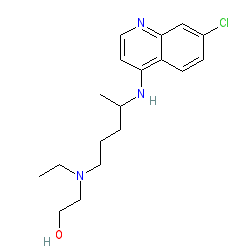|
Synonyms: Dolquine® | Plaquenil®
hydroxychloroquine is an approved drug (FDA (1955))
Compound class:
Synthetic organic
Comment: Hydroxychloroquine (HCQ) is a 4-aminoquinoline and used primarily as an antimalarial drug.
The approved drug is a racemic mixture and we show the chemical structure without stereochemistry to represent the mixture. The non-isomeric structure is also represented in the PubChem, ChEMBL and ChEBI entries listed in the links table below, while the two enantiomers forming the racemate are represented by PubChem CID 178395 and PubChem CID 178396. The marketed formulations contain hydroxychloroquine sulfate (PubChem CID 3044369). Activity at non-malarial protein targets: Although this drug has direct effects on survival of the malaria parasite it also appears to be an antagonist of two of the human TOLL-like receptors (TLR7 and TLR9). Antagonism of these receptors is likely related to the anti-inflammatory action of this drug in auto-immune diseases. Some patients with systemic lupus erythematosus (SLE) and rheumatoid arthritis are prescribed HCQ [8]. Activity against SARS-CoV-2: Hydroxychloroquine exhibits in vitro antiviral activity against both the original SARS coronavirus (SARS-CoV) [1] and SARS-CoV-2 which emerged in 2019 [6]. Extreme caution must be taken when condisering using hydroxychloroquine (HCQ) as it has severe cardiac adverse effects, and in addition its distribution to lung tissue is unknown. There was much hype around repositioning HCQ to treat COVID-19. But this was based on preliminary evidence from a cohort of COVID-19 patients in a VERY small study [3] and anecdotal evidence that patients taking HCQ for other diseases fared better if they developed COVID-19. There was also a lot of controversy around some of the larger scale trials, particularly of how they were carried out, and/or how they were reported or published. Results from subsequent well run, well powered, large scale RCTs does not support any clinical benefit from HCQ in COVID-19 patients. HCQ may even pose an acceptable risk of harm in COVID19 patients [7]. Derek Lowe's 'In the PIPELINE' blog (https://bit.ly/31C7DT1) provides a systematic and considered anaylsis of the (lack of) potential for hydroxychloroquine/chloroquine for COVID-19. Ligand Activity Visualisation ChartsThese are box plot that provide a unique visualisation, summarising all the activity data for a ligand taken from ChEMBL and GtoPdb across multiple targets and species. Click on a plot to see the median, interquartile range, low and high data points. A value of zero indicates that no data are available. A separate chart is created for each target, and where possible the algorithm tries to merge ChEMBL and GtoPdb targets by matching them on name and UniProt accession, for each available species. However, please note that inconsistency in naming of targets may lead to data for the same target being reported across multiple charts. ✖
View more information in the IUPHAR Pharmacology Education Project: hydroxychloroquine |
|
|||||||||||||||||||||||||||||||||||
| References |
|
1. Biot C, Daher W, Chavain N, Fandeur T, Khalife J, Dive D, De Clercq E. (2006)
Design and synthesis of hydroxyferroquine derivatives with antimalarial and antiviral activities. J Med Chem, 49 (9): 2845-9. [PMID:16640347] |
|
2. Delves M, Plouffe D, Scheurer C, Meister S, Wittlin S, Winzeler EA, Sinden RE, Leroy D. (2012)
The activities of current antimalarial drugs on the life cycle stages of Plasmodium: a comparative study with human and rodent parasites. PLoS Med, 9 (2): e1001169. [PMID:22363211] |
|
3. Gautret P, Lagier JC, Parola P, Hoang VT, Meddeb L, Mailhe M, Doudier B, Courjon J, Giordanengo V, Vieira VE et al.. (2020)
Hydroxychloroquine and azithromycin as a treatment of COVID-19: results of an open-label non-randomized clinical trial. Int J Antimicrob Agents, 56 (1): 105949. [PMID:32205204] |
|
4. Kawai T, Akira S. (2010)
The role of pattern-recognition receptors in innate immunity: update on Toll-like receptors. Nat Immunol, 11 (5): 373-84. [PMID:20404851] |
|
5. Lamphier M, Zheng W, Latz E, Spyvee M, Hansen H, Rose J, Genest M, Yang H, Shaffer C, Zhao Y et al.. (2014)
Novel small molecule inhibitors of TLR7 and TLR9: mechanism of action and efficacy in vivo. Mol Pharmacol, 85 (3): 429-40. [PMID:24342772] |
|
6. Liu J, Cao R, Xu X, Wang X, Zhang H, Hu H, Li Y, Hu Z, Zhong W, Wang M. (2020)
Hydroxychloroquine, a less toxic derivative of chloroquine, is effective in inhibiting SARS-CoV-2 infection in vitro. Cell Discov, 6. DOI: 10.1038/s41421-020-0156-0 |
|
7. Rosenberg ES, Dufort EM, Udo T, Wilberschied LA, Kumar J, Tesoriero J, Weinberg P, Kirkwood J, Muse A, DeHovitz J et al.. (2020)
Association of Treatment With Hydroxychloroquine or Azithromycin With In-Hospital Mortality in Patients With COVID-19 in New York State. JAMA, 323 (24): 2493-2502. [PMID:32392282] |
|
8. Silva JC, Mariz HA, Rocha Jr LF, Oliveira PS, Dantas AT, Duarte AL, Pitta Ida R, Galdino SL, Pitta MG. (2013)
Hydroxychloroquine decreases Th17-related cytokines in systemic lupus erythematosus and rheumatoid arthritis patients. Clinics (Sao Paulo), 68 (6): 766-71. [PMID:23778483] |










